![]()
![]()
![]()
Use LEFT and RIGHT arrow keys to navigate between flashcards;
Use UP and DOWN arrow keys to flip the card;
H to show hint;
A reads text to speech;
53 Cards in this Set
- Front
- Back
|
6 Roentgen signs
|
Size
Shape Location Number Margination Opacity "Never Shoot Semen On Michael Landon." |
|
|
Gas in soft tissue can come from:
|
Communication
Anaerobes Iatrogenic |
|
|
Dystrophic Mineralization can be caused by:
|
Thermal injury
Calcinosis Parasitic migration Granulomatous disease Steroid injections Chondrocalcinosis |
|
|
Metastatic mineralization can be caused by:
|
CRF
Malignant Neoplasia Hyperparathyroidism Hypervitaminosis A Hypervitaminosis D Hypoadrenocorticism (Addison's) |
|
|
List 4 mechanisms for soft tissue mineralization and why each happens.
|
1. Dystrophic - mineralization of dead tissue. Ca/P normal. Parasitic migration, Trauma
2. Metastatic - Ca/P levels elevated. CRF, Cushing's 3. Neoplastic - Due to cancer 4. Idiopathic |
|
|
3 types of new bone formation and where they occur?
|
1. Osteophyte - 2ndary to degenerative change. Found on articular surfaces. Attempt to increase stability.
2. Periosteal - Post-injury. Occurs when the cortical layer is pulled from the bone and the cambian layer grows back down. 3. endothesophyte - occurs on cartilagenous and ligamentous attachments to bone |
|
|
Name the 4 most common places for OC lesions
|
So, Can Any Human Help
Superman Lower Fat/Calories To Make The Rich Take Easier Monthly Assaults Harming Commies? Shoulder Caudal Aspect Humeral Head Stifle Lateral Femoral Condyle Tarsus Medial Trochlear Ridge Talus Elbow Medial Aspect Humeral Condyle |
|
|
2 common rad abnormalities of Panosteitis
|
usually occurs in diaphysis near nutrient foramen
fragmented/patcy appearance to the trabeculae in the area |
|
|
Two common rad abnormalities of LCP Disease?
|
flattened femoral head
Increase in bone opacity of the femoral head |
|
|
How tell between Fungal OM and Primary bone tumor?
|
Fungal - crosses joints to affect multiple bones in any region
Primary - metaphyseal region of a single bone (usually) |
|
|
What's the difference between osteomalacia and osteoporosis?
|
Porosis - loss of bone mass. Matrix is normal just not enough of it. Bones are brittle.
Malacia - matrix insufficiency. Not enough Ca or P. Bones are soft. |
|
|
What's the difference between periosteal rxn and osteophyte form'n?
|
PR is productive change at the site of damaged bone. Periosteum has been lifted off. New bone grows beneath.
OF is productive change in response to 2ndary OA. |
|
|
OC vs. OCD
|
OCD = disconnected; floating around in the joint.
|
|
|
Shoulder OC common signalment
|
6-9 mo
Lg breed male bilat |
|
|
Elbow OC common signalment
|
5-10 mo
Lg breed: Lab Bilat |
|
|
Stifle OC common signalment
|
6-11 mo
Lg breed Bilat |
|
|
Tarsal OC common signalment
|
6-12 mo
Lg breed: Rott, Lab bilat Worst prognosis |
|
|
UAP common signalment
|
5-12 mo
GSD St.B Bassets |
|
|
Panosteitis common signalment
|
5-12 mo
Lg Breed: GSD; Dobie; retrievers, bassett Male |
|
|
MO common signalment
|
Lg breed
2-7 mo |
|
|
RCC common signalment
|
Lg breed: St. B
6-12 mo distal ulnar physis mostly |
|
|
Hip Dysplasia common signalment
|
All breeds
3mo - 3 yr |
|
|
LCP Dzs common signalment
|
<20kg
4mo - 1 yr unilat |
|
|
Patellar lux common signalment
|
Small breeds
Young 4 classes: 1 - intermittent 2 - frequent 3 - permanent lux 4 - lux with tibial rotation |
|
|
HO common signalment
|
Middle aged
|
|
|
Fungal OM Common Signalment
|
Sporting dogs
Young-mid-age |
|
|
Bacterial OM common signalment
|
Any breed
Any age young/immunosuppressed |
|
|
Primary bone tumor common signalment
|
Lg Breeds
7-9 yo Usually OSA |
|
|
Draw the Salter classifications. Assign generic faces according to prognosis. Circle the most common.
|

1/2: px - good
3/4: px - guarded 5: Total Dog Replacement 2 most common. |
|

|
Premature closure of the distal radial physis
|
|

|
premature closure of the dital ulnar physis
|
|
|
Types of non-union fractures to watch out for?
|
Malunion
Nonunion viable - elephant's foot Oligotrophic viable/non-viable non-union (can't tell apart - no callus) |
|
|
OA common signalment
|
Any age, but usually older
Any breed, but usually lg |
|
|
Osteophytes vs. Enthesophytes
|
O - new bone growth
E - mineralization of jt capsule/ligs |
|
|
CCLR common signalment
|
Young, athletic - Old, fat
Female Any, but >Lg breeds |
|
|
Septic Arthritis common signalment
|
Any breed
Younger animals secondary to penetrating wound |
|
|
Erosive polyarthritis common signalment and types
|
Small: Poodles, shelties
1-9yo; avg 5 Rheumatoid Feline non-infectious polyarthritis |
|
|
Non-erosive Polyarthritis and most common type
|
Any breed (GSD)
Young-middle aged Systemic lupus Erythematosus |
|
|
Joint Neoplasia
|
M-L dogs
M-O age |
|
|
DDX for joint neoplasia
|
Synovial carcinoma
Histiocytic Carcinoma Chondrosarc Fibrosarc Synovial Myxoma |
|
|
Common causes of SST mineralization
|
Metastatic - high Ca/P
Idiopathic Neoplastic Dystrophic - dead tissue |
|
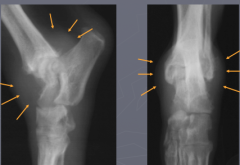
What's going on here?
|
Intracapsular swelling: centered on jt.
|
|
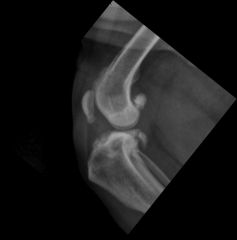
What's going on here?
|
Intracapsular swelling (fat pad displacement)
|
|
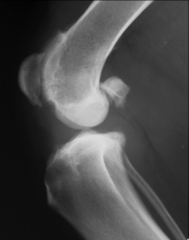
What's going on here?
|
Intracapsular swelling (compression of fat pad, displacement of fascial planes)
|
|

What's going on here?
|
Extra capsular swelling
|
|
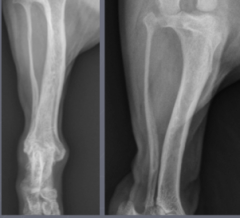
What's going on here?
|
Osteopenia (double cortical sign)
|
|
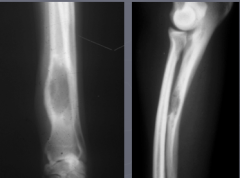
What's going on here?
|
Geographic lysis (osteoma?)
|
|
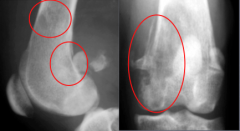
What's going on here?
|
Moth-eaten lysis
|
|
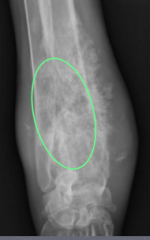
What's going on here?
|
Moth-eaten lysis
|
|
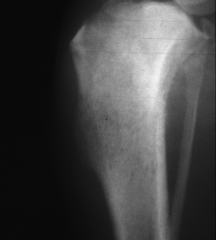
What's going on here?
|
Permeative Lysis
|
|
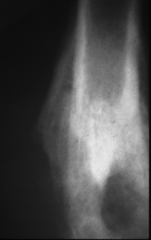
What type of periosteal reaction is this?
|
Lamellated
|
|

What type of periosteal reaction is this?
|
Columnar
|
|
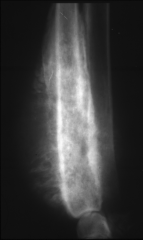
What type of periosteal reaction is this
|
Spiculated
|

